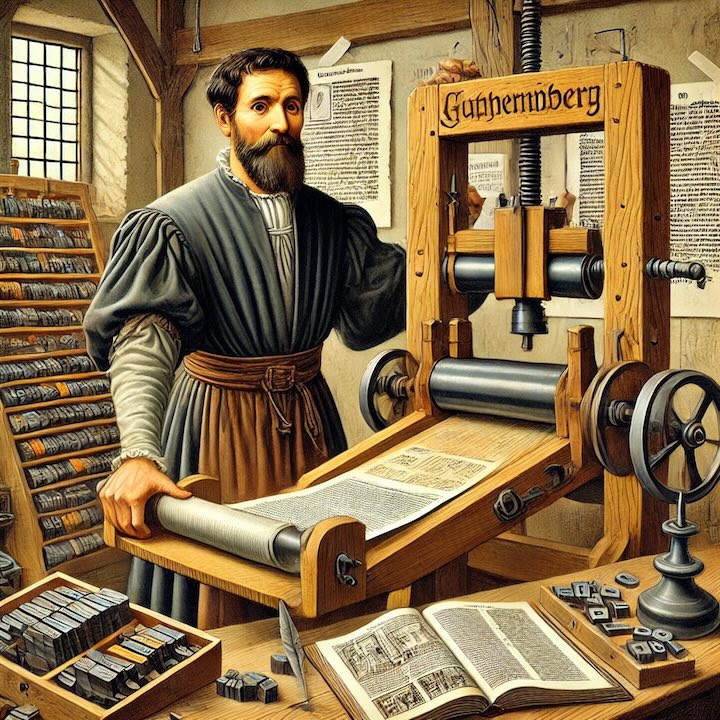
In 1450, Johannes Gutenberg invented the printing press. The invention of the press revolutionized communication and education, allowing the development of newspapers, as well as reasonably priced books. The first product of the press was the Gutenberg Bible.
In 1450, Johannes Gutenberg, a German blacksmith and inventor, revolutionized the world with the invention of the movable type printing press. This groundbreaking technology transformed communication, education, and the spread of ideas, forever altering the course of human history. Before the printing press, books were laboriously hand-copied by scribes, often taking months or even years to produce a single copy. As a result, books were rare and expensive, accessible only to the wealthiest members of society, such as nobility, scholars, and clergy.
Gutenberg’s press introduced the concept of movable type—individual letters and characters that could be rearranged and reused to create multiple copies of text. This was a major advancement over previous printing methods that used carved wooden blocks to print entire pages, a process that was slow and impractical for mass production. With Gutenberg’s system, books could be produced quickly, accurately, and in large quantities, leading to a dramatic reduction in the cost of printed materials.
The first major work produced on Gutenberg’s press was the Gutenberg Bible, also known as the 42-line Bible, due to the number of lines of text on each page. Printed around 1455, the Gutenberg Bible was a Latin Vulgate edition of the Christian Bible and is regarded as one of the most beautiful books ever printed, with its intricate gothic script and hand-illuminated initials. Only 180 copies of the Gutenberg Bible were originally printed, but even that small number represented a monumental leap forward in the availability of written works. Today, fewer than 50 complete copies of the Bible are known to exist, and they are considered some of the most valuable books in the world.
The printing press had a profound impact on society, ushering in the Information Revolution of the 15th century. Before its invention, literacy rates were extremely low due to the scarcity and high cost of books. With the ability to produce books more cheaply and in larger quantities, knowledge and information became more accessible to the masses. This democratization of knowledge played a key role in the spread of education, as books became available to a wider audience, including the burgeoning middle class.
The invention of the printing press also paved the way for the development of newspapers, journals, and other printed materials that would soon become the primary means of disseminating information. The increased availability of printed material allowed for the exchange of ideas on an unprecedented scale, fostering intellectual and cultural movements such as the Renaissance and the Protestant Reformation. Martin Luther’s 95 Theses, for example, were widely distributed across Europe thanks to the printing press, enabling the rapid spread of Protestant ideas that challenged the authority of the Catholic Church.
The printing press also transformed the way governments and political leaders communicated with the public. Laws, decrees, and official documents could be printed and distributed widely, increasing transparency and accountability. Additionally, the press allowed for the creation of reasonably priced books, making education and literacy more attainable for ordinary people.
In summary, Gutenberg’s invention of the printing press in 1450 had a transformative effect on communication, education, and the spread of ideas. The ability to produce books and printed materials on a large scale revolutionized society, promoting literacy, fostering intellectual growth, and shaping the course of history for centuries to come.
 >
>